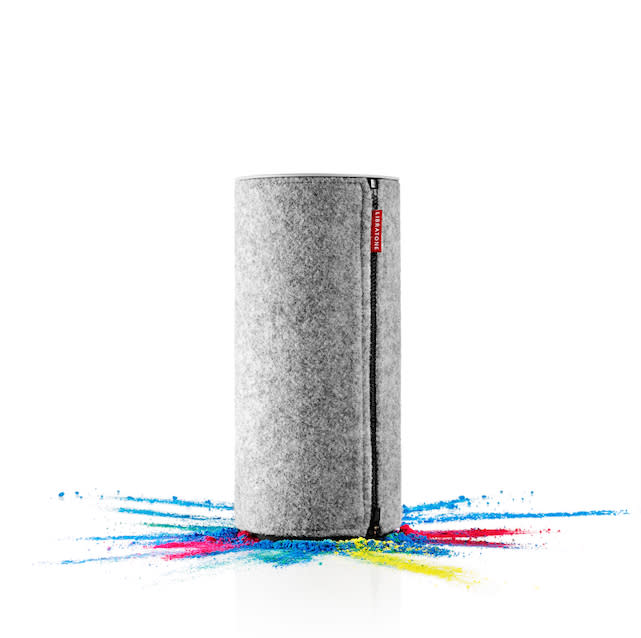Libratone Zipp Wireless Speaker: Portable, high-end audio with good looks
The Zipp (US$399.95) is the first in Scandinavian-based Libratone's range of high-end, wireless speakers, followed by the Loop, Live and Lounge. Steve Sande took a closer look at the Loop earlier this year, and while he was impressed with the quality of sound and design, the high price point and finicky setup process were some noted drawbacks. I've spent the last week or so using the Zipp. I was keen to see how the smaller Zipp compared to Steve's take on the Loop.
Design
First off, the Zipp looks great. With its tall, cylindrical shape, the Zipp is unassuming and simple in appearance, yet its changeable, woolen covers (that come in multiple colors) give it personality and life. The covers are changed by unzipping the old one and zipping on a new one -- hence: the Zipp!. The Zipp's Height is 26.0 cm (10.2") and its circumference is 12.2 cm (4.8"). The Zipp weighs 4 lbs (1.8 kg).
On top of the Zipp is a simple, circular button to power the device, with volume-up and volume-down buttons either side, not dissimilar to an Apple TV remote in appearance. There's a small LED light that indicates the Zipp's status; if all's well the LED fades in and out with a soft, white glow.
Round the back is a leather strap to carry the Zipp from room to room or out and about. Underneath the leather strap are the Zipp's inputs (3.5mm aux-in and audio USB) as well as a WiFi and PlayDirect button and a battery status indicator. Underneath is a solid base with an input for the Zipp's power supply, a rather clunky brick.
All in all, the Zipp looks great, especially with its removable cover. The Zipp's form factor means it will fit on just about any table top, counter or shelf. The only aesthetic drawback of note was the Zipp's plastic top, which feels a little, well... plasticky.
Inside the Zipp is a 60W, digital amplification 2.1 stereo system. There's a 4" bass speaker and two 1" ribbon based tweeters. There's also a lithium-ion battery that promises 8 hours of wired operation or 4 hours of wireless operation.
Performance
Thankfully, I didn't experience the same setup issues Steve did. I opted to connect the Zipp to my home's Wi-Fi network using the Libratone Zipp app on my iPad (which first did a software update on the Zipp). Once I had the Zipp connected to my home network, the Zipp appeared on my iTunes and iOS device's AirPlay menu.
It's worth noting that the Zipp can connect to your iOS or Mac via PlayDirect, where the Zipp is setup as a standalone Wi-Fi network, allowing AirPlay between the Zipp and your device without the need for a Wi-Fi network. This is a great feature, especially for a portable speaker, like the Zipp.
In terms of sound, I was really thrilled with the Zipp's performance. There was a real subtlety to the Zipp, especially in the higher ranges, where detail really shone through. This made the Zipp a truly satisfying listen. Having said that, I did find the Zipp was a little lacking in terms of weight. That's not to say it didn't have a solid punch with up-beat, bass-heavy tracks, but rather, overall, the sound could do with being slightly fuller in the low-range. Even so, the Zipp is still a fantastic listen.
The Acid's Animal is breathtaking, with the Zipp delivering so much rich detail. I was taken aback by the way reverb carries on different beats and vocal parts, and then when it's absent; the sheer dryness that is exposed. The decay-crunch on the sampled drum roll is glorious, and I found lost on lesser speakers. And all those little guitar hisses and ambient amp noises come through so well. It's testament to the recording, but also how well the Zipp delivers.
I found AirPlay performance on the whole to be good, though I did get occasional clicking sounds every now and again, despite being in good range of my router. Wired playback was without any problems, and sounded super.
Conclusion
The Libratone Zipp is a solid piece of kit. It looks the part and has fantastic sound, particularly when it comes to detail. The best part is that you can unplug it and take it anywhere, thanks to its built-in battery and PlayDirect Wi-Fi. You won't get a day's life out of the battery (especially if you're using the speaker wirelessly), but you'll be getting true high-end sound, which is more than you can say for other battery-powered portable speakers. If portability isn't a priority, there are other contenders to weigh up against the Zipp, but if high-end sound and portability are at the top of your list, check out the Zipp.


